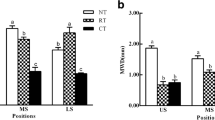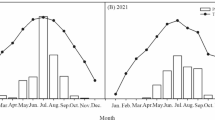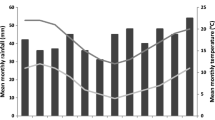Abstract
Purpose
Poor soil structure and instability are primary problems in salt-affected soil, which is formed by excessive amounts of exchangeable Na+ and inadequate cementing substances in the soil. Long-term cattle manure application is a management practice for salt-affected soil that can change the distribution of soil aggregates and increase the stability of soil aggregates.
Methods
Experiments were carried out in a randomized block design comprising 5 treatments according to the number of years of cattle manure application. Soils to which cattle manure was applied for 7, 12, 15 and 18 years were used as the experimental treatments, and soil without cattle manure application was used as the control treatment. Soil aggregate destruction, organic matter contents, and exchangeable cations were measured, and the soil percentage of aggregate destruction was calculated.
Results
The results indicated that the application of cattle manure to the salt-affected soil significantly increased the organic matter content and the exchangeable Ca2+ and Mg2+ in water-stable aggregates and significantly decreased the exchangeable Na+ and soil pH compared to those in untreated soil in all fractions (P < 0.05). The abundance of water-stable microaggregates (WSAs < 0.25 mm) was reduced, while that of mechanically stable microaggregates (MSAs < 0.25 mm) increased with increasing years of cattle manure application.
Conclusion
We concluded that applying cattle manure to salt-affected soil led to a reduction in exchangeable Na+ and increases in exchangeable Ca2+ and organic matter contents in soil aggregates; these changes caused the agglomeration of soil aggregates and thus a decrease in the soil percentage of aggregate destruction and an increase in soil aggregate stability, ultimately resulting in an increase in macroaggregate (WSAs > 0.25 mm) abundance.








Similar content being viewed by others
References
Bronick CJ, Lal R (2005) Soil structure and management. Geoderma 124:3–22. https://doi.org/10.1016/j.geoderma.2004.03.005
Chaganti VN, Crohn DM (2015) Evaluating the relative contribution of physiochemical and biological factors in ameliorating a saline-sodic soil amended with composts and biochar and leached with reclaimed water. Geoderma 259–260:45–55. https://doi.org/10.1016/j.geoderma.2015.05.005
Chorom M, Rengasamy P (1995) Dispersion and zeta potential of pure clays as related to net particle charge under varying pH, electrolyte concentration and cation type. Eur J Soil Sc 64:657–665. https://doi.org/10.1111/j.1365-2389.1995.tb01362.x
Cui Q, Xia JB, Yang HJ, Liu JT, Shao PS (2021) Biochar and effective microorganisms promote Sesbania cannabina growth and soil quality in the coastal saline-alkali soil of the Yellow River Delta. China Sci Total Environ 756:143801. https://doi.org/10.1016/j.scitotenv.2020.143801
Debuysera A, Tessier D (2004) Soil physical properties affected by long-term fertilization. Eur J Soil Sci 55:505–512. https://doi.org/10.1111/j.1365-2389.2004.00614.x
Elliott ET (1986) Aggregate Structure and Carbon, Nitrogen, and Phosphorus in Native and Cultivated Soils. Soil Sci Soc Am J 50:627–633. https://doi.org/10.2136/sssaj1986.03615995005000030017x
Gaffar MO, Ibrahim YM, Wahab DAA (1992) Effect of farmyard manure and sand on the performance of sorghum and sodicity of soils. J Ind Soc Soil Sci 40:540–543
Gharaibeh MA, Eltaif NI, Shunnar OF (2009) Leaching and reclamation of calcareous saline-sodic soil by moderately saline and moderate-SAR water using gypsum and calcium chloride. J Plant Nutr Soil Sci 172:713–719. https://doi.org/10.1002/jpln.200700327
Goldberg S, Glaubig RA (1987) Effect of saturating cation, pH, and aluminum and iron oxide on the flocculation of kaolinite and montmorillonite. Clays Clay Miner 35:220–227. https://doi.org/10.1346/CCMN.1987.0350308
Guo K, Liu XJ (2014) Dynamics of meltwater quality and quantity during saline ice melting and its effects on the infiltration and desalinization of coastal saline soils. Agric Water Manag 139:1–6. https://doi.org/10.1016/j.agwat.2014.03.007
Guo K, Zhang XM, Li XJ, Liu XJ (2010) Effect of freezing saline water irrigation in winter on the reclamation of coastal saline soil. Resour Sci 32:431–435. CNKI:SUN:ZRZY.0.2010-03-008
Han LJ, Liu DW, Cheng GS, Zhang GC, Wang LX (2019) Spatial distribution and genesis of salt on the saline playa at Qehan Lake, Inner Mongolia, China. Catena 177:22–30. https://doi.org/10.1016/j.catena.2019.01.040
Huang XR, Li H, Li S, Xiong HL, Jiang XJ (2016) Role of cationic polarization in humus-increased soil aggregate stability. Eur J Soil Sci 67:341–350. https://doi.org/10.1111/ejss.12342
Lakhdar A, Rabhi M, Ghnaya T, Montemurro F, Jedidi N, Abdelly C (2009) Effectiveness of compost use in salt-affected soil. J Hazard Mater 171:29–37. https://doi.org/10.1016/j.jhazmat.2009.05.132
Li JG, Pu LJ, Zhu M, Zhang J, Li P, Dai XQ, Xu Y, Liu LL (2014) Evolution of soil properties following reclamation in coastal areas: a review. Geoderma 226:130–139. https://doi.org/10.1016/j.geoderma.2014.02.003
Li TT, Zhang YL, Bei SK, Li XL, Reinsch S, Zhang HY, Zhang JL (2020) Contrasting impacts of manure and inorganic fertilizer applications for nine years on soil organic carbon and its labile fractions in bulk soil and soil Aggregates. Catena 194:104739. https://doi.org/10.1016/j.catena.2020.104739
Liu ML, Wang C, Liu XL, Lu YC, Wang YF (2020) Saline-alkali soil applied with vermicompost and humic acid fertilizer improved macroaggregate microstructure to enhance salt leaching and inhibit nitrogen losses. Appl Soil Ecol 156:103705. https://doi.org/10.1016/j.apsoil.2020.103705
Lozupone CA, Knight R (2007) Global patterns in bacterial diversity. P Natl Acad Sci USA 104:11436–11440. https://doi.org/10.1073/pnas.0611525104
Manasa MRK, Katukuri NR, Nair SD, Yang HJ, Yang ZM, Rong BG (2020) Role of biochar and organic substrates in enhancing the functional characteristics and microbial community in a saline soil. J Environ Manage 269:110737. https://doi.org/10.1016/j.jenvman.2020.110737
McConnell DB, Shiralipour A, Smith WH (1993) Compost application improves soil properties. Biocycle 34:61–63
Muneer M, Oades JM (1989) The role of Ca-organic interactions in soil aggregate stability. III. Mechanisms and models. Aust J Soil Res 27:411-423. https://doi.org/10.1071/SR9890411
Myers HE (1937) Physicochemical reactions between organic and inorganic soil colloids as related to aggregate formation. Soil Sci 44:331–359. https://doi.org/10.1097/00010694-193711000-00001
Rabbi SMF, Minasny B, McBratney AB, Young LM (2020) Microbial processing of organic matter drives stability and pore geometry of soil aggregates. Geoderma 360:114033. https://doi.org/10.1016/j.geoderma.2019.114033
Rabot E, Wiesmeier M, Schlüter S, Vogel HJ (2018) Soil structure as an indicator of soil functions: a review. Geoderma 314:122–137. https://doi.org/10.1016/j.geoderma.2017.11.009
Rasool R, Kukal SS, Hira GS (2007) Soil physical fertility and crop performance as affected by long term application of FYM and inorganic fertilizers in rice–wheat system. Soil till Res 96:64–72. https://doi.org/10.1016/j.still.2007.02.011
Rath KM, Fierer N, Murphy DV, Rousk J (2019) Linking bacterial community composition to soil salinity along environmental gradients. ISME J 13:836–846. https://doi.org/10.1038/s41396-018-0313-8
Savinov NO (1936) Soil physics. Sielchozgiz, Moscow
Singh K (2016) Microbial and enzyme activities of saline and sodic soils. Land Degrad Dev 27:706–718. https://doi.org/10.1002/ldr.2385
Smith GI (1977) Playas and dried lakes: occurrence and development. Quat Res 7:145–146. https://doi.org/10.1016/0033-5894(77)90018-7
Sun YP, Yang JS, Yao RJ, Chen XB, Wang XP (2020) Biochar and fulvic acid amendments mitigate negative effects of coastal saline soil and improve crop yields in a three year field trial. Sci Rep 10:8946. https://doi.org/10.1038/s41598-020-65730-6
Wong VNL, Greene RSB, Dalal RC, Murphy BW (2010) Soil carbon dynamics in saline and sodic soils: a review. Soil Use Manage 26:2–11. https://doi.org/10.1111/j.1475-2743.2009.00251.x
Xie WJ, Chen QF, Wu LF, Yang HJ, Zhang YP (2020) Coastal saline soil aggregate formation and salt distribution are affected by straw and nitrogen application: A 4-yearfield study. Soil Tillage Res 198:104535. https://doi.org/10.1016/j.still.2019.104535
Zhang Q, Zhou W, Liang GQ, Sun JW, Wang XB, He P (2015) Distribution of soil nutrients, extracellular enzyme activities and microbial communities across particle size fractions in a long-term fertilizer experiment. Appl Soil Ecol 94:59–71. https://doi.org/10.1016/j.apsoil.2015.05.005
Zhang XM, Guo K, Xie ZX, Feng XH, Liu XJ (2012) Effect of frozen saline water irrigation in winter on soil salt and water dynamics, germination and yield of cotton in coastal soils. Chin J Eco-Agric 20:1310–1314. https://doi.org/10.3724/SP.J.1011.2012.01310
Zhang Y, Yang JS, Yao RJ, Wang XP, Xie WP (2020) Short-term effects of biochar and gypsum on soil hydraulic properties and sodicity in a saline-alkali soil. Pedosphere 30:694–702. https://doi.org/10.1016/S1002-0160(18)60051-7
Zheng H, Wang X, Chen L, Wang ZY, Xia Y, Zhang YP, Wang HF, Luo XX, Xing BS (2018) Enhanced growth of halophyte plants in biochar amended coastal soil: roles of nutrient availability and rhizosphere microbial modulation. Plant Cell Environ 41:517–532. https://doi.org/10.1111/pce.12944
Acknowledgements
The authors sincerely appreciate the staff of the laboratory of Soil Degradation Control and Remediation, School of Resources and Environment, and Northeast Agricultural University. This study was funded by the National Natural Science Foundation of China (42177320).
Author information
Authors and Affiliations
Contributions
All authors contributed to the study conception and design. Soil samples were collected by Shuo Zhao, Fei Yu, Cheyu Zhai, Rui Zhong, Zhao Ying and Yong Wang laboratory analysis of soil samples was done by Shuo Zhao, data collection and analysis were performed by Shuo Zhao. The manuscript was written by Shuo Zhao and all authors commented on the manuscript. Manuscript was reviewed and edited by Qingfeng Meng and Juan Zhang, and all authors read and approved the final manuscript.
Corresponding author
Ethics declarations
Ethical approval
I would like to declare on behalf of my co-authors that the content has not been published or submitted for publication elsewhere, in whole or in part. All the authors listed have approved the manuscript that is enclosed.
Data availability
Date and results were honestly, and without fabrication, falsification or inappropriate data manipulation.
Conflict of interest
The authors have no competing interests to declare that are relevant to the content of this article.
Additional information
Responsible editor: Yan He
Publisher's Note
Springer Nature remains neutral with regard to jurisdictional claims in published maps and institutional affiliations.
Rights and permissions
Springer Nature or its licensor holds exclusive rights to this article under a publishing agreement with the author(s) or other rightsholder(s); author self-archiving of the accepted manuscript version of this article is solely governed by the terms of such publishing agreement and applicable law.
About this article
Cite this article
Zhao, S., Yu, F., Zhai, C. et al. Long-term effects of cattle manure application on the soil aggregate stability of salt-affected soil on the Songnen Plain of North-Eastern China. J Soils Sediments 23, 344–354 (2023). https://doi.org/10.1007/s11368-022-03317-6
Received:
Accepted:
Published:
Issue Date:
DOI: https://doi.org/10.1007/s11368-022-03317-6




